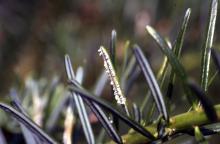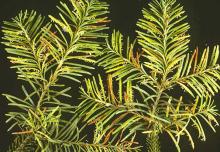See:
Bracken Fern (Pteridium aquilinum) - Rust
Cause The principal rust in Oregon is Uredinopsis pteridis. In Washington both U. pteridis and Pucciniastrum goeppertianum are common. U. pteridis will infect all true fir (noble, grand, concolor, silver, balsam, and Shasta) and its alternate host is bracken fern. The disease is more prevalent on seedlings and saplings. Rusts vary in intensity from year to year. Cool, moist springs favor disease development.
Infection occurs during May and June. A slight discoloration of severely infected needles may occur in fall or winter. Tube-like aecia develop the next spring and for 1 or 2 more years. Aeciospores can infect bracken fern any time in the growing season. Several spore stages occur on the fern, some of which can reinfect other bracken fern. Telia develop on the fern and overwinter in dead fronds. Spores germinate in spring and then reinfect other fir.
P. goeppertianum will infect grand, silver, balsam, and subalpine firs. The alternate hosts are Vaccinium spp., including huckleberry, blueberry, and cranberry. Similar conditions favor this rust; however, a uredinial state has not been found.
Willow rust, Melampsora abieti-capraearum, has been reported on Abies spp. from all states. The alternate host is willow (Salix spp.).
Symptoms The most characteristic symptom is the white tube-like fruiting structures (aecia) on the lower needle surface. Aecia of U. pteridis can mature on current-year needles in fall or winter but usually develop on previous year's needles in spring. Aecia of P. geoppertianum can mature on current-year needles in late summer or on previous year's needles in early summer. These fruiting structures contain the aeciospores. Uredinopsis spores are white or colorless, P. goeppertianum are yellow. Severe infections will result in needle drop. Aeciospores can be found on needles of all age classes. Melampsora infections develop orange-yellow, elongate aecia on current-year needles.
Symptoms on fern are chlorotic markings on the upper surface and white pustules (uredinia) on the lower surface.
Symptoms on Vaccinium include a witches' broom of thickened stems with few or no leaves. Telia form in a reddish-brown layer around stems each year.
Symptoms of willow are indistinguishable yellowish leaf spots.
Cultural control Remove and destroy the alternate host for at least 1,000 ft around plantations. Simply waiting until late summer and applying an herbicide will not prevent sporulation on bracken fern in spring.
Chemical control Best used before infections are likely to occur from bud break through new shoot growth.
- Armada 50 WDG at 3 to 9 oz/100 gal water. Do not use a silicone-based surfactant. Not for nursery or greenhouse use. Group 3 + 11 fungicide. 12-hr reentry.
- Banner MAXX at 16 fl oz/100 gal water is registered for Pucciniastrum on Shasta fir in nurseries and landscape plantings. It may be useful for Uredinopsis in spring during or shortly after budbreak. Group 3 fungicide. 12-hr reentry.
- Eagle 20 EW at 6 to 12 fl oz/100 gal water plus a spray adjuvant is labeled for "Christmas Trees" as well as Douglas-Fir. Group 3 fungicide. 24-hr reentry.
- Heritage at 1 to 4 oz/100 gal water plus a non-silicone-based wetter sticker. Registered for conifers including Christmas trees. Group 11 fungicide. 4-hr reentry.
- Terraguard SC at 2 to 8 fl oz/100 gal water is labeled for Christmas tree/conifer plantations. Group 3 fungicide. 12-hr reentry.
- Ziram 76 DF at 2 lb/100 gal water is registered for Shasta fir. Group M3 fungicide. 48-hr reentry.
Reference Ziller, W.G. 1974. The Tree Rusts of Western Canada. Canadian Forestry Service Publication 1329.




